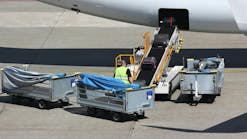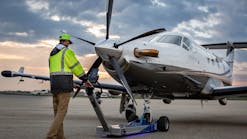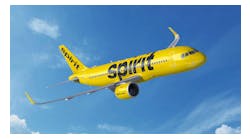Feb. 25 -- On a spring morning in 2003, Gerard Arpey was scrambling to leave his Colleyville home when his 5-year-old daughter, Alexandra, asked him what he was doing for the day.
Arpey, who had been appointed chief executive of American Airlines a few weeks earlier, was heading to a crucial meeting of the airline's top management.
There he would unveil his blueprint for lifting the company from its dire financial straits.
For days, he and his executive team had been working nearly around the clock to plan the future of North Texas' largest employer while keeping bankruptcy at bay.
Arpey explained to Alexandra that he was having a "show-and-tell" with his friends at work. Alexandra darted to her room and returned with a purple papier-mâche dinosaur she had made.
"She was very excited," Arpey recalls. "She said: 'Daddy, you have to show them this. It's a dinosaur with magical flying powers.'''
A few hours later, after presenting his turnaround plan to the crowd of executives and managers at the airline's Fort Worth headquarters, Arpey showed off Alexandra's dinosaur.
"If anybody needs magical flying powers," he told his colleagues, "it's us."
Today, the dinosaur has a prominent place on Arpey's desk, and some American executives like to credit its "magical flying powers" for keeping the airline aloft while most of its rivals -- United, Northwest, Delta, US Airways -- descended into bankruptcy.
Last year, Fort Worth-based American posted its first annual profit since 2000, after a wrenching five years that saw the carrier bleed more than $8 billion.
American stayed out of bankruptcy court by building up a cash reserve, slashing $6 billion in annual costs and finding new sources of money, such as charging for curbside check-in and selling maintenance services to other airlines.
The seeds of that turnaround, which came after a remarkable period of financial shocks, lie in the straightforward plan Arpey and his team put together during those frantic weeks in May 2003.
"That was a really, really extraordinary time," Arpey said. "I've never experienced anything like it."
Future at stake
Arpey, who's now 48, had been given what he calls a "battlefield promotion" to American's top job. His predecessor, Don Carty, had resigned amid an employee uproar over the disclosure of a slate of executive bonuses and retirement perks after workers approved $1.6 billion in wage and benefit cuts.
The concessions had kept American out of bankruptcy for the moment, but Arpey says the airline remained on the brink for months.
"We had this real cash crisis; we were trying to figure out how to keep the lights on," he said.
That pressure continued long after the employees approved the concessions, he said.
"Many were simply advocating throughout 2003 and much of 2004 that we simply file for bankruptcy," Arpey said.
The pressure was coming from creditors and analysts, as well as some executives at the airline.
Gary Kennedy, the airline's general counsel, was ready to fly to New York at a moment's notice and file the papers.
"We were ready to pull the trigger at any time," said Dan Garton, American's executive vice president of marketing.
In the first days of his tenure, Arpey juggled the pressure of operating a severely distressed company with the need to plan for the future. He began a series of meetings with other executives and, in some cases, union leaders, in the executive suites on the sixth floor of American's Fort Worth headquarters. The meetings often ran late.
He asked some very basic questions: What sort of airline do you want American to be? How do you think we can get there?
"We realized that we didn't know what the endgame was going to be," Garton said.
He cites a 1990s push by Delta Air Lines to reduce its costs to 7.5 cents per seat-mile, which was dubbed "Leadership 7.5."
"The Delta thing sounded great, but as soon as the market changed, it went out the window," he said. "So we decided to define the highway instead of the destination."
Arpey wanted a simple outline for an effective turnaround plan.
He also wanted it to have some teeth.
"We didn't want this to just be the slogan of the month," Garton said. "You want people to take it seriously."
The late-night discussions sometimes got heated.
"We were talking about our futures," he said. "People felt very passionate about things."
A few executives, worried that the airline wasn't going to survive, attempted to resign. Arpey pleaded with them to stay.
"It would have been extraordinarily disruptive to lose some of these people," he said. "So, I don't know if strong-armed is the right word, but I really challenged them and called on their sense of history with our company."
Most decided to stay, Arpey said, despite the opportunity to earn significantly more money elsewhere.
The group eventually agreed on a plan with four principles, which Arpey dubbed "tenets," that have become a mantra for American executives:
"Lower costs to compete."
"Fly smart, give customers what they value."
"Pull together, win together."
"Build a financial foundation for our future."
"The words were chosen very carefully and after much debate," Arpey said. "These words had to mean something."
They charted some substantial policy changes that demonstrated that the plan was more than just talk. The most drastic one was to add more seats to the airline's coach cabins, reducing the amount of legroom and eliminating the airline's popular "more room throughout coach" promotion.
Arpey also decided to dramatically reduce the airline's costly hub in St. Louis, cutting 210 flights and 2,000 employees. The airline had acquired the hub just a few years earlier when it bought TWA.
"We were looking at our situation with fresh eyes," Arpey said. "We were forced to confront the reality that certain things just were not working."
Arpey rolled the plan out to the rest of the world at American's annual shareholders' meeting on May 21, 2003. He had been chief executive for 27 days.
"Returning the airline to health and profitability is going to require a much broader plan," he told investors. "We will be bringing new leadership, new thinking and fresh approaches to the challenges confronting us."
American executives have since framed every major project or new program in terms of the four tenets. They appear seemingly everywhere -- in the company's financial reports, in internal correspondence and employee communications.
A plan to increase flight-crew productivity at the airline's hubs was part of "lower costs to compete." The decision to simplify the carrier's complex fare structure was a result of "fly smart, give customers what they value."
Debt and equity offerings, which created a vital cash cushion, were done to "build a financial foundation for our future."
"You have to say it constantly," Garton said.
The most challenging tenet, however, was "pull together, win together."
Daunting legacy
A few weeks after declaring that American could survive only if employees and management worked together, Arpey gathered about 50 top executives and managers in a conference room.
He asked them to describe in one word how they viewed the airline's labor relations and wrote them on a large easel in the front of the room.
"The words were really devastating," he said. "It was words like 'confrontational,' 'hostile,' 'belligerent,' 'destructive.'â??"
Then he asked them to describe what they would like to see when dealing with unions. On another easel he wrote down words like "partnership," "trust" and "cooperation."
"I'm not sure yet how we're going to do it," Arpey told the group. "But we've got to build a bridge from this board to that one."
The drive to repair the airline's famously bitter labor relations was an audacious plan, and many executives were openly skeptical. At the suggestion of Jeff Brundage, a former pilots' union negotiator whom Arpey brought in to head labor relations, American hired the Overland Resource Group, a consulting firm that would act as a "marriage counselor" between unions and management.
John Darrah, who was then the president of the Allied Pilots Association, said union leaders were granted unusual access to executives and information, and were giving their advice and perspective on a variety of issues.
"We were in the loop -- certainly a lot more than had been the case in the past," he said.
For several years, the program seemed to be working. Union leaders and management worked together on a host of initiatives, the most substantial being a plan to begin working on outside maintenance contracts at American's bases in Fort Worth, Tulsa and Kansas City.
In 2005, union leaders and executives spoke about their partnership on a panel at an industry conference in Phoenix.
It was the first time that labor and management had made a joint appearance.
"The only way we can have secure jobs, a secure pension, a secure future is if we work together to make this a successful company," Arpey said last week. "That's the cornerstone of everything."
Arpey said he knew early on that there would be bumps in the road, and, indeed, a major obstacle has soured some of the success of that tenet. Employee anger over a slate of stock-based management bonuses caused the pilots' union to drop out of most joint programs with management last year.
And Darrah predicts that pilot-contract negotiations, which began last year, would be contentious.
"I think they're going to be extremely confrontational," he said. "The outlook of the membership has changed radically, from a certain moderation to a majority now that's very, very worked up."
Plan pays off
Even as the cost cuts kicked in, other obstacles arose.
The war in Iraq dampened international travel, newcomer Independence Air slashed fares on the East Coast, and severe acute respiratory syndrome cut demand for flights to Asia.
But the biggest problem was the cost of jet fuel, which was rising steadily.
As he left office in mid-2004, union leader Darrah told pilots that the airline was lagging in its financial projections by $1 billion.
And American again nearly descended into bankruptcy in fall 2005, after several hurricanes damaged oil refineries along the Gulf Coast.
The spot price of jet fuel, which had been rising anyway, quickly jumped to as high as $2.40 per gallon, an increase of nearly 60 percent. American quickly began burning up the financial cushion it had worked so hard to build.
In 2005, the airline spent $1.7 billion more on fuel than it had the previous year, for a total of $5.6 billion, or about 27 percent of the airline's total expenses. American booked about $20.7 billion in revenues that year.
The jump in fuel prices helped push both Delta and Northwest airlines into bankruptcy protection. Meanwhile, Dallas-based rival Southwest Airlines kept fares low in competing markets.
That airline had protection from spiking oil costs thanks to contracts that locked in fuel purchases at lower prices.
"That was mega-frightening," Garton said. "I don't think people realized how significant the threat was then. After all that work, we were very close to bankruptcy again."
Arpey said American rode out the storm only because of the turnaround plan.
"There were a lot of tense moments," he said. "It was disappointing to us to burn through all the liquidity we had worked so hard to build."
Still, Arpey stuck to his instinct that bankruptcy should be a last resort.
"Bankruptcy is the failure of those with a stake in the company to get around a table and solve your problems," he said. "All you're doing in bankruptcy is turning it over to bankers and lawyers and judges to do what you've failed to do."
He points to the experiences of Delta and Northwest, which have struggled despite bankruptcy and are often cited as takeover targets.
"If you look at the results of those who have gone through Chapter 11, it's not a magic potion to solve your problems," he said.
The next year finally saw American's fortunes improve. Demand for travel shot up, and fares rose as Southwest's fuel hedges began to expire. American boosted its revenue by almost 9 percent to $22.6 billion and turned its first profit in six years.
Tom Horton, American's chief financial officer, cautions that the profit, although welcome, was a modest $231 million on $22.5 billion in revenues -- a margin of just about 1 percent.
He added that it only signals the beginning of another phase of the airline's restructuring.
American must now focus on paying down its debt, which totals $18.4 billion including long-term leases, funding its pensions and preparing for major financial commitments like upgrading its fleet. And it faces some challenging contract negotiations over the next few years.
"Once we're making a profit, then we can start the real work," Horton said. "So it's going to be a while before we can really say American is turned around."
Arpey, meanwhile, hopes that the purple dinosaur perched on his desk will continue to preside over continued improvements in his airline's condition.
But he added, with a laugh, that his daughter hasn't asked about her contribution to American's turnaround.
"My kids really still don't have any idea what I do here," he said. "If you'd ask them, they'd say I'm the guy who cooks them pancakes on the weekends."
Turnaround timeline
2003
April 24: Don Carty resigns as CEO of American Airlines, and the airline's board appoints Gerard Arpey. His first directive -- file for bankruptcy, unless unions agree to approve $1.6 billion in concessions.
April 25: The unions agree to approve the deal, and American avoids bankruptcy. Arpey begins meeting with executives to create a turnaround plan.
May 15: American wrests $175 million in savings from lenders and creditors but warns that bankruptcy is still possible.
May 21: Arpey unveils his turnaround plan at the airline's annual shareholders meeting.
Oct. 22: American decides to keep its three maintenance bases open, rather than outsourcing work like many rivals.
2004
Nov. 23: American defers $2.7 billion in aircraft purchases.
2005
Jan. 6: American simplifies its fare structure, reducing many business fares, matching a program launched by Delta Air Lines.
October: American is again pushed to the brink of bankruptcy after hurricanes push the price of jet fuel up nearly 60 percent.
2006
April: American pays executives nearly $100 million in a stock-bonus deal that outrages union leaders.
2007
January: American reports its first annual profit since 2000 despite crushing fuel costs. It credits years of cost-cutting coupled with higher fares and revenue.
"The only way we can have secure jobs, a secure pension, a secure future is if we work together to make this a successful company. That's the cornerstone of everything."
-- Gerard Arpey, CEO
"We were forced to confront the reality that certain things just were not working."
-- Gerard Arpey, CEO
"[Alexandra] said: 'Daddy, you have to show them this. It's a dinosaur with magical flying powers.'â??"
-- CEO Gerard Arpey, talking about the purple dinosaur his daughter made
Copyright (c) 2007, Fort Worth Star-Telegram, Texas Distributed by McClatchy-Tribune Business News. For reprints, email , call 800-374-7985 or 847-635-6550, send a fax to 847-635-6968, or write to The Permissions Group Inc., 1247 Milwaukee Ave., Suite 303, Glenview, IL 60025, USA.
Copyright 2005 LexisNexis, a division of Reed Elsevier Inc. All rights reserved.
Terms and Conditions | Privacy Policy
News stories provided by third parties are not edited by "Site Publication" staff. For suggestions and comments, please click the Contact link at the bottom of this page.





